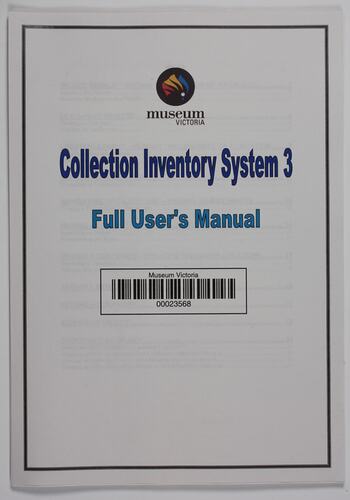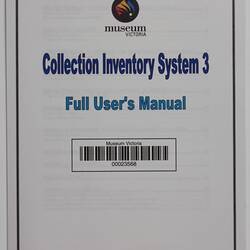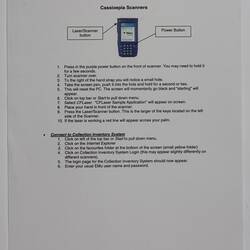Summary
Manual and instructions sheets produced by MV staff (Natalia Fraser).
In mid 2001, MV developed version one of what has come to be known as the Museum Victoria Collection Inventory System. It was at this stage that four Cassiopeia hand held computers were purchased to enable staff to operate MvCIS. These devices were similar to domestic "Pocket PC" handheld computers, but had strengthened casing, built in barcode scanners, and wireless networking capability.
The Cassiopeia Pocket PCs used by Museum Victoria (MV) were purchased specifically for use with the Collection Inventory System (MvCIS). MvCIS was developed completely in-house and works with the Museum's central collection database KE EMu. It was essentially designed to provide MV with a system to capture and maintain 100% inventory control over its cultural collections and sections of the Natural Sciences. Inherent to the successful operation of the system was barcode technology - a fast, accurate and reliable technology which promised to significantly reduce the time required to maintain precise location control for hundreds of thousands of objects.
The units were initially used by the History and Technology collection department to capture barcode and location information during the relocation of a section of the collection from the Moreland Annex to its new home at Melbourne Museum. This process commenced with the scanning of the first barcode by Natalia Fraser on the 30th August 2001. The Cassiopeias continued to be used at Museum Victoria until taken out of circulation in late March 2005. By this time, wireless networking technology had become widespread. Increased awareness had led to a proclivity for hackers to attempt to break into unprotected wireless networks. The Cassiopeias no longer offered the level of security that was required of them. Other hand held units on the market were now offering far higher levels of data encryption.
Natalia Fraser (Co-ordinator, Collection Inventory System at MV) and Neville Quick (Manager, Collection & Research Facilities at MV) supplied a detailed account of the use of the Cassiopeia Pocket PCs.
Physical Description
Manual- Icon Explanation: Single A4 sheet, colour printed. Scanner Start-up Manual: Single A4 sheet, colour printed. Full User's Manual: A4 document - 35 pages, colour printed and held at top left hand corner with small bull-dog clip.
Significance
The Cassiopeia Pocket PCs used by Museum Victoria (MV) were purchased specifically for use with the Collection Inventory System (MvCIS). MvCIS was developed completely in-house and works with the Museum's central collection database KE EMu. It was essentially designed to provide MV with a system to capture and maintain 100% inventory control over its cultural collections and sections of the Natural Sciences. Inherent to the successful operation of the system was barcode technology - a fast, accurate and reliable technology which promised to significantly reduce the time required to maintain precise location control for hundreds of thousands of objects.
In mid 2001, MV developed version one of what has come to be known as the Museum Victoria Collection Inventory System. It was at this stage that four Cassiopeia hand held computers were purchased to enable staff to operate MvCIS. These devices were similar to domestic "Pocket PC" handheld computers, but had strengthened casing, built in barcode scanners, and wireless networking capability.
The units were initially used by the History and Technology collection department to capture barcode and location information during the relocation of a section of the collection from the Moreland Annex to its new home at Melbourne Museum. This process commenced with the scanning of the first barcode by Natalia Fraser on the 30th August 2001. The Cassiopeias continued to be used at Museum Victoria until taken out of circulation in late March 2005. By this time, wireless networking technology had become widespread. Increased awareness had led to a proclivity for hackers to attempt to break into unprotected wireless networks. The Cassiopeias no longer offered the level of security that was required of them. Other hand held units on the market were now offering far higher levels of data encryption.
Natalia Fraser (Co-ordinator, Collection Inventory System at MV) and Neville Quick (Manager, Collection & Research Facilities at MV) have supplied a detailed account of the use of the Cassiopeia Pocket PCs.
More Information
-
Collecting Areas
-
Acquisition Information
Transfer
-
Manufacturer
-
Place Used
Museum Victoria, Melbourne, Greater Melbourne, Victoria, Australia, circa 2001
-
Inscriptions
Manual- Icon Explanation: At top: MvCIS 3/Icon Explanation Scanner Start-up Manual: At top: SCANNER START UP//Cassiopeia Scanners Full User's Manual: On front: museum/VICTORIA//Collection Inventory System 3/Full User's Manual
-
Classification
-
Category
-
Discipline
-
Type of item
-
Object Measurements
210 mm (Width), 295 mm (Height)
A4 sheets
-
References
D. Demant has and is continuing to interview staff who have participated in the development of the Museum's database. Various manuals and objects have been collected in this on-going project
-
Keywords
Barcodes, Computers, Computing, Databases, Handheld Personal Computers, Manuals, Scanners





